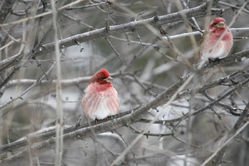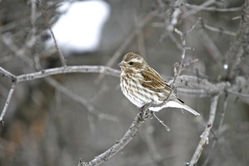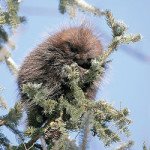By David Benson

Late winter is finch time. When the cone supply runs out in other areas, flocks of finches sometimes show up at this time of year. One of the most common finches is the purple finch. The name of this species (like so many others!) is a bit misleading. Not purple at all, male purple finches are suffused with a dusky rose color over bold brown-and-white streakiness. Females lack the rose color.
Purple finches are woodland birds. They usually nest in coniferous forests, but they will also nest in mixed coniferous-deciduous woodlands. They are “tree birds,” that sing from trees, forage from trees, and nest in trees. They used to be more common at feeders, but the incursion of house sparrows and now, house finches, into towns and cities has apparently moved the purples finches back to the forest.

If you live in town, you may confuse house finches with purple finches; they are closely related and somewhat similar in appearance. Both species are streaky, brown, sparrow-like birds with thick, conical bills and notched tales. Male house finches sport some red, but it is most often an orange-red, and it is limited to the face, head, and rump. The red on male purple finches can almost cover the body, as if the bird were dipped in juice. Female purple finches have two, broad, pale, roughly-parallel stripes on the side of the face; female house finches have blank faces. Purple finches are blockier, more robust-looking birds, but this is difficult to tell without direct comparison.
Male purple finches sing a bright, warbly, long song, usually from perches at the tops of trees. The flight call is a flat, “pink” call—one of the most common and easily-identifiable flight calls during migration along the North Shore. When you learn to identify the call, you may be able to look up and catch a glimpse. As the winter drags on, and spring lingers in coming, watch for the rose color and listen for the bright song of the purple finch.




